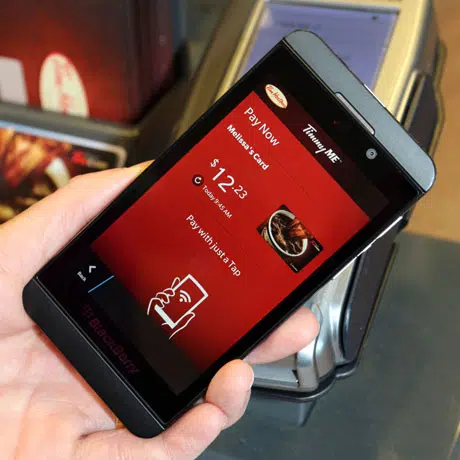
North American coffee chain Tim Hortons has launched an NFC mobile payments service using Host Card Emulation (HCE) at 3,500 locations in Canada and 800 in the United States. It is currently available to customers with BlackBerry 10 smartphones and support for Android phones will be added in January 2014.
To use the new Quickpay service, customers link their existing prepaid Tim Card to their TimmyMe mobile app. They can then use NFC to tap and pay at standard contactless terminals, regardless of their network operator. Their card balance is stored with payment processing company First Data.
“The app does use HCE,” Tim Hortons confirmed to NFC World. “The current offering is unique to BlackBerry 10 — including the Blackberry Q5, Blackberry Q10, Blackberry Z10 and BlackBerry Z30 smartphones. However, we are working towards an Android 4.4 KitKat launch slated for January.”
Google introduced support for Host Card Emulation (HCE) in October 2013, with the release of version 4.4 of Android KitKat, enabling any Android NFC device to be used for mobile payments and other secure applications without the need to have access to a secure element.
“We chose NFC because of the speed and convenience along with leveraging our existing infrastructure to deploy this mobile payment application,” Tim Hortons told NFC World. “This gave us complete control over the deployment of the system and further opportunity to grow our best-in-class customer experience.”
The chain has also launched a barcode payment pilot program in the Niagara region of Canada and at select US Tim Hortons Cafe & Bake Shop restaurants in Maine, Michigan, New York and Ohio.
The barcode technology, which provides a scan-to-pay option once a Tim Card has been registered on the TimmyMe app, supports Apple devices running iOS 6.0 or later and Android devices running version 4.0 or later.
Next: Visit the NFCW Expo to find new suppliers and solutions
Way to go Tim Horton. Congratulations. First Data is a great partner. We have been allowing Timmy patrons the tap and pay feature for about a year and a half now and are super glad HCE helped you wrap the payment around the user experience! For retailers wanting to leverage HCE to enhance their user experience you can do it for free through our HCE SDK wiki.SimplyTapp.com
The HCE just store a card number in smartphone or not?Is your cardagent connect to your server to identify the card number is llegal?What’s the real solution to keep the card number security to stop the copy?And can they use the service ok if the customer can not connect to server.
Good thing no one uses iphones anymore…oh…wait
Yes, just wait.
In the meantime the iPhone crowd will be just fine with those big old barcodes.
I’ve been using Passbook on my iPhone at Starbucks for the past two years. I even used it in Thailand and Hong Kong. Nice that Tim’s is just now catching up, albeit on Android and Blackberry.
Try using Tim’s NFC when you’re overseas! Lol.
Big old barcodes in teeny tiny screens…
They’re down to 12% market share, so it makes sense to focus on the 80%+, albeit choosing RIM first was clearly a mistake.
It’s because RIM was ahead of everyone else on this technology, I guess. They’ve had HCE for a while, but it was only an esoteric feature until it popped up in Android too.
Well they are both Canadian companies, Timmy Ho’s and RIM. Maybe Timmys should buy RIM.
I’m sure if apple add’s NFC then they will make the service work with those phones too.
Maybe some day Apple will add’s NFC.
Funniest joke I’ve heard in a while!
Agree, Don‘t guess apple.
Isn’t Starbucks’ barcode system more secure? After all, there is no transmission of data, other than the bar code number which deducts the amount from the preloaded Starbucks Card. So what’s the advantage of Near Field Communications over a barcode reader? The barcode is already cross platform. When I deal with Starbucks, I’m dealing with Starbucks, not a third party financial enabler. I’m skeptical about security.
It would be pretty easy for me if I’m behind you in line to start filming from my phone, film your screen and save the barcode from any one of those frames.